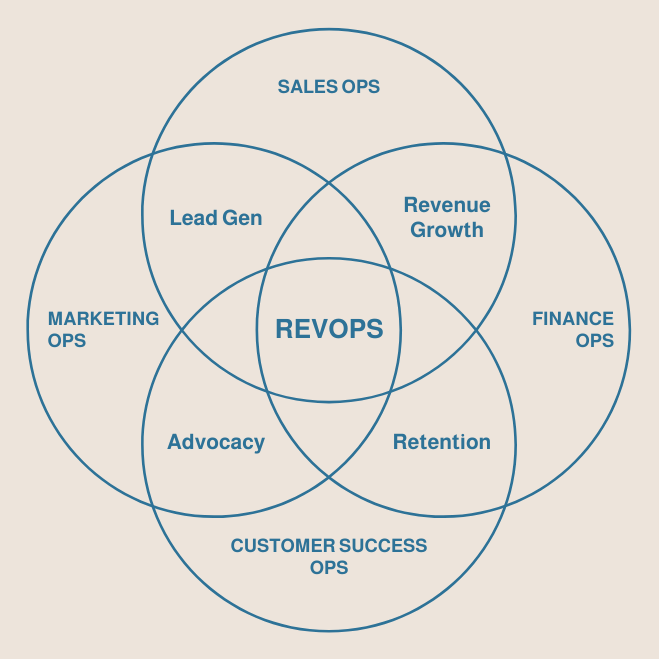What is RevOps?
A Modern Approach to Revenue Growth
Revenue Operations (RevOps) is the business function that brings Sales, Marketing, Customer Success, and Finance into alignment around one set of goals, data, and processes.
Instead of each GTM team operating in silos, RevOps acts as the connective framework that integrates strategy, systems, data, processes, and enablement to drive scalable and predictable revenue growth.
Why RevOps Matters for SaaS Growth
High-growth SaaS companies face two challenges:
Data silos — Revenue information is spread across multiple tools, leading to conflicting reports and poor decision-making.
Scaling pains — As companies grow, broken hand-offs, inaccurate forecasts, and inefficient processes hold back growth.
RevOps solves these problems by creating one source of truth and aligning all GTM teams. This leads to better forecasting accuracy, faster sales velocity, and stronger customer retention.
As Salesforce describes it, RevOps is about managing the entire revenue lifecycle — from lead to renewal.
The 5 Pillars of RevOps
A true RevOps function touches every part of the revenue engine. The five pillars of RevOps are:
Strategy — revenue models, pricing, commissions, and GTM design.
Data — reports and dashboards to support strategic decisions.
Processes — efficient workflows and lifecycle hand-offs that support data integrity.
Systems — CRM, automation, integrations, and analytics.
Enablement — playbooks, onboarding, and training to drive adoption.
Together, these pillars create operational efficiency and align all teams on one path to growth.
RevOps vs. SalesOps: What’s the Difference?
Many people confuse RevOps with SalesOps, but the scope is very different:
SalesOps supports only the sales team with processes, tools, and reporting.
RevOps spans all GTM functions (Sales, Marketing, Customer Success, and Finance), ensuring cross-functional alignment and shared accountability.
RevOps is not just a reporting function or “SalesOps with a new name.” It’s a strategic discipline that drives both growth and operational clarity across the business.
How RevOps Aligns GTM and Finance
RevOps ensures that GTM strategy and financial planning are tightly connected. By partnering with Finance, RevOps leaders make sure the numbers Sales and Marketing report internally match the numbers Finance reports externally to investors and leadership.
This alignment builds revenue reliability, not just revenue generation.
RevOps in Action: Benefits for Scaling Companies
When implemented correctly, RevOps enables SaaS companies to:
Scale with predictable revenue growth.
Unify Sales, Marketing, CS, and Finance under one strategy.
Strengthen forecasting and executive decision-making with accurate dashboards.
Increase efficiency through automation and system integration.
Build resilience in shifting markets by creating flexible operations.
Ready to Put RevOps to Work?
RevOps isn’t just theory — it’s a framework for scaling SaaS companies with confidence.
Explore my fractional RevOps packages, book a consultation, or contact us to see how RevOps can accelerate your company’s growth.
RevOps FAQs
What are the benefits of RevOps for SaaS companies?
Improved forecasting accuracy, stronger GTM alignment, scalable processes, and more reliable revenue growth.
When should a company hire RevOps?
Most companies hire a RevOps leader at Series B, or when they hit 60 employees. Before their first full-time hire, many companies start with a fractional RevOps consultant.
Which department should RevOps sit under?
A VP or Director of RevOps should report to the COO or CFO. RevOps must remain unbiased — if it reports into Sales or Marketing, it risks being pulled toward that team’s priorities.
How much experience should a SaaS company’s first RevOps hire have?
Aim for Director level or higher. You want someone who has scaled a business before and can eventually build out a team.
Can RevOps be used for non-SaaS companies?
Absolutely. In fact, non-SaaS industries are the fastest-growing part of RevOps adoption in 2025, as companies across finance, healthcare, manufacturing, and professional services see the value of cross-functional alignment.
Are RevOps leaders usually system admins?
At smaller companies, yes — the first RevOps hire often manages all GTM tools as the primary system admin. In more mature teams, there’s usually a dedicated systems admin who reports to the RevOps leader.



